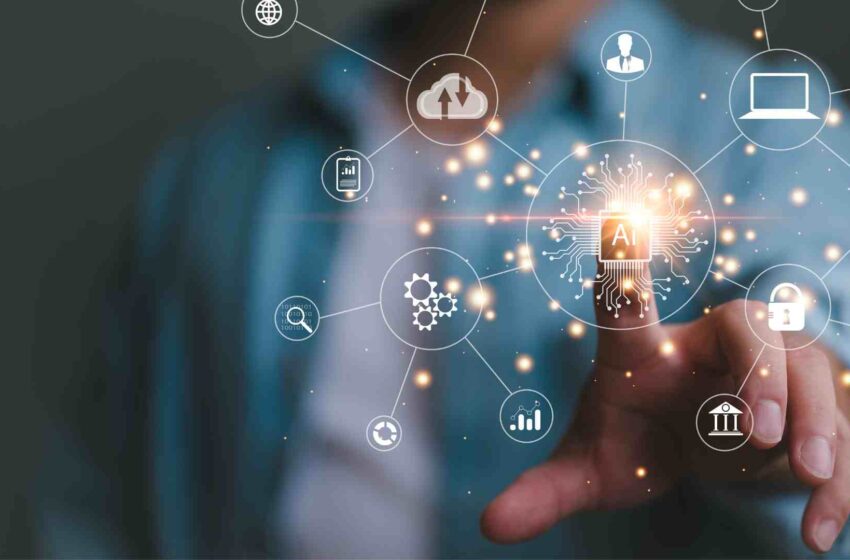
Top 5 Uses of AI in Business
AI tools help companies move faster in their business models. They can speed up the clock for everything from design to commercialization.
Examples of AI include voice assistants like Siri and Alexa; generative language models such as ChatGPT, which pair programmers to write code faster; image recognition software; music and film recommendations on streaming platforms; and cancer diagnostics on x-rays.
AI in Agriculture
In agriculture, AI is being used to improve crop viability, decrease waste and increase efficiency. Food that is lost or wasted uses up valuable water, land and energy resources, as well as contributes to greenhouse gas emissions. With the increasing demands for food, farming companies and farmers must maximize their productivity while decreasing their use of resources. AI can help achieve these goals by accelerating and automating processes, eliminating human error, and helping to improve the accuracy of decisions.
AI has helped farmers to better understand their crop health and weeds through real-time monitoring and alerts. It can also be used to identify the right time for weed control, irrigation and fertilization. Additionally, AI has been used to reduce pests and disease through automated identification and eradication.
Moreover, AI has been used to monitor soil conditions and determine the best combination of nutrients for each field. This allows for better soil quality and higher yields.
The potential for AI in agriculture is vast, but it’s important to note that there are still challenges with implementing this technology. For example, the agricultural industry is less technologically advanced than other industries and often doesn’t have the infrastructure to support AI solutions. Thankfully, technology providers can make the process of adopting AI easier for farmers by offering simpler solutions at first and allowing them to build on these over time.
In addition, AI can help increase productivity by reducing labor costs and improving safety. It can be used to monitor and optimize machinery performance, increase yields by predicting the best planting and harvesting times, and enable round-the-clock monitoring of crop growth. This allows for quicker and more accurate response to weather fluctuations, which can have a significant impact on crops.
AI in Healthcare
While there are a number of benefits to AI in healthcare, there is concern that this technology could also eliminate jobs and cause disruptions in the industry. It is important that any changes are implemented carefully and only when the industry is ready for them. In addition, there is a risk that patients may become uncomfortable with the use of artificial intelligence in their care. It is essential that all stakeholders find a way to balance the needs of patients with the need for innovation in the field.
AI can automate administrative tasks, such as pre-authorizing insurance claims and following up on unpaid bills, to ease the workload of medical professionals and save money. Additionally, it can analyze massive amounts of patient data to deliver more accurate diagnoses and better treatment plans.
It can also help improve the quality of care by reducing errors, such as coding mistakes and false claims. These mistakes can be costly for healthcare organizations and can result in delays in reimbursements. AI can also predict which patients are likely to pay their bills on time, making it easier for hospitals to manage their accounts receivable.
Another benefit of AI in healthcare is that it can provide real-time results of MRIs, CT scans and ultrasounds. This allows doctors to see the test results instantly and make a diagnosis quickly. It also reduces costs and minimizes waiting times for patients, which is an especially important benefit in a high-pressure environment like a hospital. In addition, it can connect patients with doctors remotely and offer advice on medical questions. This can be particularly helpful in situations where patients are unable to visit clinics or hospitals due to illness, disability or distance.
AI in Education
Many educational institutions are incorporating AI into their teaching tools. The positive applications of this technology include automating tasks, delivering more personalized learning, and streamlining administrative tasks to allow teachers time to focus on the needs of their students. This will help make education more accessible to students worldwide, regardless of socioeconomic status.
AI can also help improve student outcomes by analyzing a student’s performance and progress, creating adaptive lessons, and providing individualized tutoring for students who need extra practice. This can be especially helpful for struggling students who can’t get the attention they need from a teacher. Additionally, AI can provide personalized feedback on essays and assignments to help students improve their writing.
In addition to its ability to adapt to different learning styles, AI can also help students prepare for tests and self-examinations by recommending additional study materials and suggesting questions that are similar to past assessments. Similarly, it can provide students with a virtual study buddy by guiding them through the process of answering math problems or explaining difficult concepts in a more accessible way.
Finally, artificial intelligence can be used to help make global classrooms available to students with visual or hearing impairments. For example, a free plug-in called Presentation Translator can create subtitles in real time for what a teacher is saying during a class. This technology can also be used to help students who have difficulty taking notes in a class by recording lectures and converting them into transcripts using speech-to-text.
However, some educators are concerned that the use of AI in education may reduce student interaction with both teachers and classmates. This could lead to an increase in the public health crisis of loneliness and isolation identified by the U.S. Surgeon General. It is important for educational institutions to have policies in place that address this issue and ensure that student data privacy remains intact.
AI in Transportation
AI in transportation is helping to streamline operations, reduce costs and increase efficiency. From intelligent train automation to navigation systems that make it easier for drivers to navigate the oceans, AI is making a difference in this industry.
The technology is being applied to both passenger and freight transportation. For example, autonomous cars are becoming more popular, and AI is enabling them to operate safely by monitoring road conditions and predicting potential hazards. This can help drivers avoid dangerous weather, as well as improve the car’s performance by analyzing past driving behavior.
Smart traffic management is another area where AI in transportation can make a huge difference. Using machine learning algorithms, AI can monitor traffic flow and congestion in cities and towns, and make recommendations to improve it. This type of intelligent traffic management helps to reduce travel times and prevent accidents. It also allows traffic controllers to predict problems before they occur, such as road closures and construction sites. The Italian motorway company Autostrade per l’Italia, for instance, relies on an AI-based monitoring system that automatically detects incidents and queues and adjusts traffic lights accordingly.
Other applications of AI in transportation include detecting dangerous driving and identifying drivers with alcohol or drug use. AI systems can also detect signs of vehicle problems, such as an engine malfunction or battery issues. These technologies help law enforcement agencies to respond quickly and efficiently.
It is important for transportation practitioners to understand what AI is and how it works. They can then make informed decisions about when to use the technology and how to best implement it. This will help them to maximize the benefits while mitigating risks and communicating effectively with customers.
AI in Retail
Retailers are using AI to improve customer experience, streamline supply chain processes, and enhance profitability. Some of the most popular uses of AI in retail include recommendations, personalization, and inventory management.
Retail AI software can gather data on customers through various methods and analyze it to understand their buying habits and preferences. Then, the system can send personalised product recommendations to each customer. This is a great way to increase sales and customer loyalty. It also helps retailers save time and money by reducing staff workloads.
Another way retailers use AI in retail is by analyzing customer shopping patterns to predict future demand for products. This allows them to optimize inventory levels and avoid stockouts. Moreover, it can help reduce the number of products that are marked down due to low demand or discarded because they are out of style. This will also help them save on storage costs and reduce the risk of loss.
In addition to this, AI can help retailers track and automate their supply chains. By using sensors and IoT devices, the system can collect and analyze data on inventory levels and customer traffic. It can then make decisions about what to reorder and when, based on the data. This will improve efficiency and accuracy, and reduce the need for manual intervention.
AI can also help retail stores detect theft or other suspicious behavior in store and at the checkout line. For example, Stitch Fix uses AI to recommend clothing items to customers by analyzing their order history and profile information. It can also identify when a customer’s size or preferences change, and automatically adjust the order accordingly. This will help reduce the chances of theft and improve the overall shopping experience for customers.







